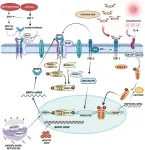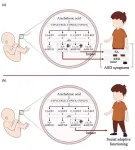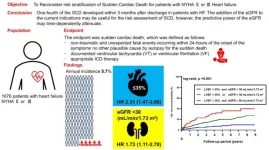(Press-News.org)
Asbestos, a group of naturally occurring fibrous minerals, has been historically used for its durability and resistance to heat. Despite its advantageous properties, asbestos is a well-documented carcinogen, linked to diseases such as lung cancer (LC) and malignant pleural mesothelioma (MPM). The controversy surrounding the degree of carcinogenicity of different asbestos types, especially chrysotile versus amphibole asbestos, continues to influence scientific and regulatory discussions. This review delves into the various aspects of asbestos-related research, focusing on historical context, risk assessment, environmental presence, diagnostic challenges, and the influence of research quality and industry.
Historical Context and Risk Assessment
Asbestos has been utilized in various industries due to its fireproofing and insulating properties. However, the health risks associated with asbestos exposure were identified as early as the 20th century. The epidemiological data from high-risk occupational settings provided compelling evidence of the link between asbestos exposure and LC as well as MPM. Despite regulatory efforts to limit asbestos use, the latency period of asbestos-related diseases means that new cases continue to emerge decades after exposure.
Asbestos in the Environment
Asbestos fibers enter the environment through both natural erosion and industrial activities. Air, soil, and water contamination often results from land excavation, tunneling, and other non-asbestos-specific industries. Studies have shown that asbestos fibers are present in a significant percentage of routine post-mortem examinations, including in children, suggesting widespread environmental exposure. The debate over the health implications of low-level environmental exposure persists, with some arguing that there is a threshold for safe fiber content in the air.
Mesothelioma and Diagnostic Challenges
MPM is notoriously difficult to diagnose due to its rarity and non-specific symptoms. Misdiagnosis is common, particularly in the general population where MPM may be confused with other cancers. The accurate diagnosis of MPM is crucial for attributing cases to occupational exposure and for epidemiological studies. Advances in diagnostic techniques have improved detection rates, but challenges remain, especially in differentiating MPM from other malignancies.
Chrysotile vs. Amphibole Asbestos
A widely accepted view is that amphibole asbestos (e.g., amosite, crocidolite) is more carcinogenic than chrysotile asbestos. However, both types pose significant health risks. Experimental data often show similar levels of carcinogenicity between serpentine (chrysotile) and amphibole asbestos in both animal models and cellular studies. Human epidemiological data suggest that chrysotile may have a lower relative risk for LC and MPM compared to amphiboles, but the differences are not always consistent across studies. The varying results highlight the need for further independent research to clarify these discrepancies.
Quality of Research and Industry Influence
The quality of asbestos-related research significantly impacts the conclusions drawn about its carcinogenicity. Meta-analyses have shown that higher quality studies tend to report less disparity between the carcinogenic potential of chrysotile and amphibole asbestos. Industry influence and conflicts of interest have been noted in some studies, where data may be selectively reported or manipulated to downplay the risks associated with chrysotile asbestos. Independent and unbiased research is essential to provide a clearer understanding of the true health risks of asbestos.
Conclusions
The carcinogenicity of asbestos is well-established, yet the degree of risk associated with different fiber types remains a topic of debate. While regulatory measures have reduced asbestos use, legacy exposures continue to pose health risks. Future research should focus on high-quality, independent studies to resolve existing controversies and ensure that public health policies are based on robust scientific evidence. The ongoing challenge is to balance the historical and industrial benefits of asbestos with the imperative to protect human health from its well-documented hazards.
Full text
https://www.xiahepublishing.com/2835-3315/CSP-2022-00028
The study was recently published in the Cancer Screening and Prevention.
Cancer Screening and Prevention (CSP) publishes high-quality research and review articles related to cancer screening and prevention. It aims to provide a platform for studies that develop innovative and creative strategies and precise models for screening, early detection, and prevention of various cancers. Studies on the integration of precision cancer prevention multiomics where cancer screening, early detection and prevention regimens can precisely reflect the risk of cancer from dissected genomic and environmental parameters are particularly welcome.
Follow us on X: @xiahepublishing
Follow us on LinkedIn: Xia & He Publishing Inc.
END
NCSA Director Bill Gropp and two former Center directors were chosen for the first-ever HPCwire “35 Legends” list in celebration of the publication’s 35th anniversary.
Thirty-five honorees will be announced each year, selected by HPCwire editors and advisors based on their contributions to the high-performance computing community over the past 35 years and celebrated for the different ways they’ve helped move HPC forward.
Gropp, NCSA’s Founding Director Larry Smarr and Former Director Daniel Reed were among the first 17 honorees announced in July. The remaining HPCwire 35 Legends will be ...
A study led by the Centro Nacional de Investigaciones Cardiovasculares (CNIC) and Fundación SHE, supported by “la Caixa” Foundation, demonstrates that teaching healthy habits through classroom activities helps to prevent the accumulation of abdominal fat during the first school years.
The study, published in the Journal of the American College of Cardiology (JACC), is one of the largest contemporary school-based health promotion studies and has one of the most extensive participant follow-up schedules.
The conclusions are clear: early intervention to promote healthy habits in elementary school children can be more ...
β-Thalassemia is a genetic disorder characterized by reduced or absent synthesis of the beta chains of hemoglobin, leading to ineffective erythropoiesis and severe anemia. Patients with transfusion-dependent β-thalassemia (TDT) require regular blood transfusions to maintain adequate hemoglobin levels. Non-transfusion-dependent thalassemia (NTDT) patients manage their anemia without regular transfusions but still experience significant health complications. Iron overload is a common and severe complication in both TDT and NTDT patients ...
Autism spectrum disorder (ASD) is a neurodevelopmental disorder that affects learning capability and social behavior of people. Over the past few decades, awareness regarding ASD has increased, especially regarding its prevalence and effect on the lives of people diagnosed with ASD. However, several aspects related to ASD are not well understood, leaving much to be explored.
Although the exact causes of ASD are unclear, currently available evidence points to neuroinflammation as a major factor. Several studies in mouse models of ASD have hinted at the importance of polyunsaturated ...
Patients with congestive heart failure (CHF) having a compromised blood supply, are at greater risk of sudden cardiac death (SCD). With an estimated incidence as high as 22% among these patients, current clinical guidelines recommend using implantable cardioverter defibrillators (ICDs) to help mitigate the risk of SCD.
Although the application of ICDs in patients with CHF is backed by substantial evidence, these studies did not include people with chronic kidney disease (CKD), who are an important clinical population. In other ...
SARS-CoV-2, the virus responsible for COVID-19, is widespread among wildlife species, according to Virginia Tech research published Monday (July 29, 2024) in Nature Communications. The virus was detected in six common backyard species, and antibodies indicating prior exposure to the virus were found in five species, with rates of exposure ranging from 40 to 60 percent depending on the species.
Genetic tracking in wild animals confirmed both the presence of SARS-CoV-2 and the existence of unique viral mutations with lineages closely matching variants circulating in humans at the time, further supporting human-to-animal transmission, the study found.
The highest exposure to SARS ...
There are significant differences in how much people are exposed to air pollution, according to a new study co-authored by MIT scholars that takes daily mobility into account.
The study, based in the Bronx, New York, does not just estimate air pollution exposure based on where people live or work, but uses mobile data to examine where people go during a typical day, building a more thorough assessment of the environment’s impact on them.
The research finds exposure to particulate matter 2.5 microns or bigger rises by about 2.4 percent when daily travel patterns are taken into account.
“One of the main strengths of the study is that we ...
A research team led by UC San Diego has, for the first time, shown that a wearable, non-invasive device can measure activity in human cervical nerves in clinical settings.
The device records what the team calls Autonomic Neurography (ANG), neural activity from the human vagus and carotid sinus nerves as well as other autonomic nerves found in the skin and muscle of the neck. The vagus nerve is a “superhighway” of the involuntary nervous system, with tendrils extending from the base of the skull through the torso and abdomen to influence digestion, heart rate and the immune system. The vagus nerve ...
The vast majority of American voters think alike on what they find important in life, but both Republicans and Democrats fail to recognise their shared views and values, according to new research from the Universities of Bath and Essex.
This finding is revealed today in the academic journal Social Psychological and Personality Science less than a month after the US Republican presidential nominee Donald Trump survived an assassination attempt when a gunman shot at him during a campaign rally.
“There’s a general perception ...
A new generation of specialty optical fibres has been developed by physicists at the University of Bath in the UK to cope with the challenges of data transfer expected to arise in the future age of quantum computing.
Quantum technologies promise to provide unparalleled computational power, allowing us to solve complex logical problems, develop new medicines and provide unbreakable cryptographic techniques for secure communications. However, the cable networks used today to transmit information across the globe are likely to be sub-optimal for quantum communications, due to the solid cores of their optical fibres.
Unlike regular optical ...






